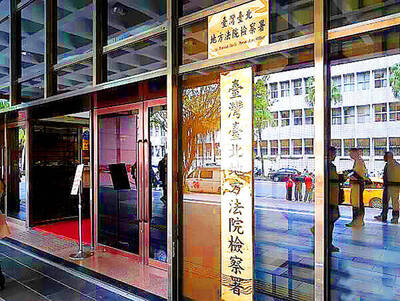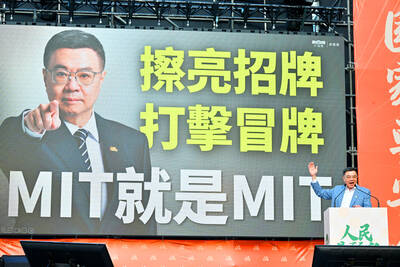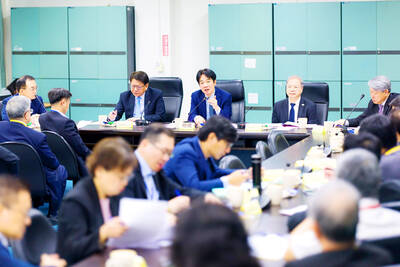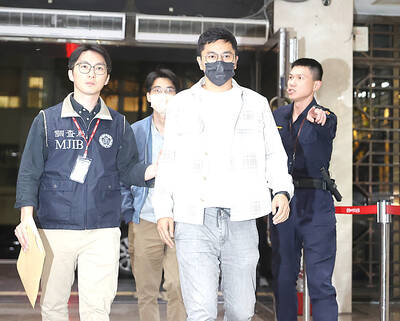Contradicting his previous pledge that the proposed referendum on the Fourth Nuclear Power Plant in New Taipei City’s (新北市) Gongliao District (貢寮) would not be held until the plant’s operational safety could be guaranteed, Premier Jiang Yi-huah (江宜樺) yesterday said he was not sure about the matter.
Jiang said he was unable to say with absolute certainty that the referendum would only be held once the facility passes a safety inspection because it is impossible to know how long a safety check would take, as they do not have a predetermined duration. In addition, the Central Election Commission, not the Cabinet, has the mandate to set the referendum date, he said.
Jiang made the remarks in response to media queries after he made a tour of the power plant yesterday and listened to a briefing on the safety inspection plan.

Photo: CNA
Jiang has reiterated on several occasions that it would not be necessary to stage a referendum if safe operation of the Fourth Nuclear Power Plant remains a concern because in that case the government would not issue an operating license once it is completed and therefore it could not operate.
The change in Jiang’s position came after President Ma Ying-jeou (馬英九) said in a recent interview with the Chinese-language Apple Daily that the safety inspection and referendum should not be linked.
During the visit, representatives of Taiwan Power Co (Taipower, 台電), the plant’s operator, sought to reassure Jiang and reporters that the Gongliao plant would be better able to withstand natural disasters than Japan’s Fukushima Dai-ichi nuclear power plant — which experienced a meltdown after the March 11, 2011, tsunami and earthquake — in seven aspects.
Among those was a 48,000-tonne fresh water tank, which the Fukushima Dai-ichi plant was not equipped with, that would hold enough water to cool the rectors for three days in an emergency scenario, Taipower said.
The Fourth Nuclear Power Plant also has two backup power sources in case of power outages, which the Japanese plant did not, it said.
Plant deputy general manager Lin Rong-yi (林榮宜), who has worked at power plants for 30 years, said he was unhappy that the plant’s design and construction had been labeled as “patchwork.”
“For those of us who specialize in nuclear technology, it’s called technology integration,” Lin said.
Any high-tech product, such as a nuclear power plant, is a synthesis of advanced technologies; even a smartphone is composed of components manufactured by many different firms, Lin said.

INVESTIGATION: The case is the latest instance of a DPP figure being implicated in an espionage network accused of allegedly leaking information to Chinese intelligence Democratic Progressive Party (DPP) member Ho Jen-chieh (何仁傑) was detained and held incommunicado yesterday on suspicion of spying for China during his tenure as assistant to then-minister of foreign affairs Joseph Wu (吳釗燮). The Taipei District Prosecutors’ Office said Ho was implicated during its investigation into alleged spying activities by former Presidential Office consultant Wu Shang-yu (吳尚雨). Prosecutors said there is reason to believe Ho breached the National Security Act (國家安全法) by leaking classified Ministry of Foreign Affairs information to Chinese intelligence. Following interrogation, prosecutors petitioned the Taipei District Court to detain Ho, citing concerns over potential collusion or tampering of evidence. The

TRADE: The premier pledged safeguards on ‘Made in Taiwan’ labeling, anti-dumping measures and stricter export controls to strengthen its position in trade talks Products labeled “made in Taiwan” must be genuinely made in Taiwan, Premier Cho Jung-tai (卓榮泰) said yesterday, vowing to enforce strict safeguards against “origin laundering” and initiate anti-dumping investigations to prevent China dumping its products in Taiwan. Cho made the remarks in a discussion session with representatives from industries in Kaohsiung. In response to the US government’s recent announcement of “reciprocal” tariffs on its trading partners, President William Lai (賴清德) and Cho last week began a series of consultations with industry leaders nationwide to gather feedback and address concerns. Taiwanese and US officials held a videoconference on Friday evening to discuss the

NEGOTIATIONS: The US response to the countermeasures and plans Taiwan presented has been positive, including boosting procurement and investment, the president said Taiwan is included in the first group for trade negotiations with the US, President William Lai (賴清德) said yesterday, as he seeks to shield Taiwanese exporters from a 32 percent tariff. In Washington, US Trade Representative Jamieson Greer said in an interview on Fox News on Thursday that he would speak to his Taiwanese and Israeli counterparts yesterday about tariffs after holding a long discussion with the Vietnamese earlier. US President Donald Trump on Wednesday postponed punishing levies on multiple trade partners, including Taiwan, for three months after trillions of US dollars were wiped off global markets. He has maintained a 10 percent

PERSONAL DATA: The implicated KMT members allegedly compiled their petitions by copying names from party lists without the consent of the people concerned Judicial authorities searched six locations yesterday and questioned six people, including one elderly Chinese Nationalist Party (KMT) member and five KMT Youth League associates, about alleged signature forgery and fraud relating to their recall efforts against two Democratic Progressive Party (DPP) legislators. After launching a probe into alleged signature forgery and related fraud in the KMT’s recall effort, prosecutors received a number of complaints, including about one petition that had 1,748 signatures of voters whose family members said they had already passed away, and also voters who said they did not approve the use of their name, Taipei Deputy Chief Prosecutor